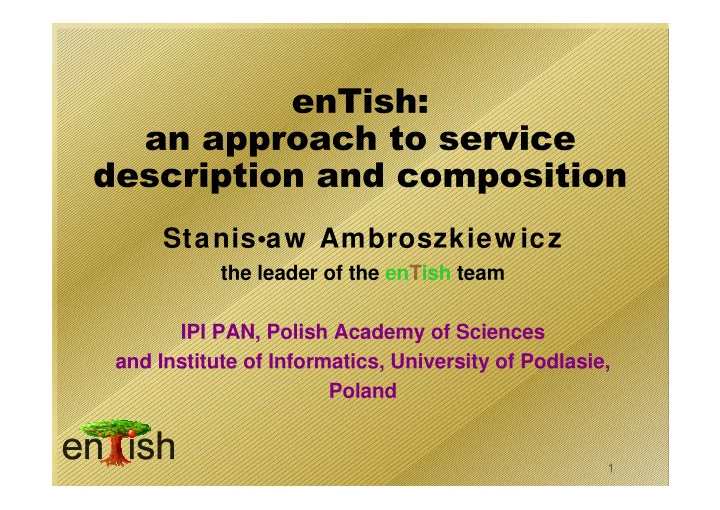

Stanis•aw Ambroszkiew icz the leader of the enTish team IPI PAN, Polish Academy of Sciences and Institute of Informatics, University of Podlasie, Poland 1
According to SOA paradigm the clients’ requests y (tasks) are to be realized whereas the services are to be used y What is service composition for? y For creating sophisticaticated business procesess (BPEL4WS, WSCI, BPML, DAML-S, SELF-SERV) – procedural approach (How to do?) y y service architecture corresponds to SOAP + WSDL to SOAP + WSDL service architecture corresponds y For realizing clients’ task (SWORD, XSRL, enTish)- declarative approach (What to do?) y the task is specified explicitely; a protocol for task realization is needed y y more sophisticated service architecture is required more sophisticated service architecture is required 2
for declarative approach z The second layer has two interrelated components: raw application (Function), and Filter. z Raw application implements a single input-output operation. z Given a specification of the desired output to be produced by the raw application (Function), the Filter replies with specifications of the required input. 3
serviceRegistry serviceRegistry middleware iddleware m (broker) (broker) discovery publication Services Services clients lients’ ’ tasks tasks c register Send task ( applications applications) ) ( application and get result invocation, coordination, Service Service transaction requestor provider The challenge: How to realize such middlew are? 4
middlew are You can join You can create a your application task, deliver as service input resources, via API and get the final result You can define your own data types, functions, relations; i.e., you own 5 ontology
y the idea: y service is represented by service-agent y client’s task is represented by task-agent y the agents speak one common language according to a conversation protocol y the conversation protocol is for service publication, discovery, composition, invocation, and transactions the basic components of the middleware: y y agents and y conversation language 6
state.xsd, message.xsd common State schema for task-agent and service-agent: y Goal, I ntentions, Commitments, Knowledge Message: z Header: y From, To, Protocol, Order z Body: y a list of evaluated formulas of the contents language 7
formula.xsd z Contents language is a simple version of typed FOL without quantifiers: y all names in the language are URIs that point to concrete data y names for types, functions, relations, variables y terms and formulas are defined in the standard way in the schema formula.xsd z evaluated formula is defined in the schema info.xsd: y formula y time&place stamp signature (optional in the current version) y 8
definitions.xsd z contents language is open and eXtensible: y you can introduce your own ontology as an instance of definitions.xsd, i.e., introduce new types, new functions, and new relations to the language z upper ontology for sdc: y properEntish.xml is an instance of definitions.xsd y basic primitive concepts: agent, service, resource, intentions, commitments, timeout, ... z formula examples: y task formula: ?z= f(?x, g(?y)) and timeout(t0) y intention formula: • implies intentions( agent0 ) 9
y agents and services exchange messages with specific contents in order to realize: y service publication y service discovery y arranging services into a workflow y worklow execution and control y distributed transaction 10
z workflow composition phase – the idea: y agent sends message to service0: „my intention is • ” y service replies: „I commit to realize • if you realize • ” y „• ” becomes the next intention of the agent y agent is looking for a service that can realize „• ” y suppose service1 could realize „• ” y agent sends message to the service1: „my intention is • ” y and so on ... more in enTish-Docs.pdf 11
say nothing that isn’t worth saying y the first version of enTish specs was completed (see enTish-DOCUMENTATI ON.pdf) y enTish is a working technology ! y prototype was realized (October 2002), is ready for testing and evaluation via three www interfaces starting with www.ipipan.waw.pl/ mas/ y work in progress on the next independent implementations 12
Recommend
More recommend